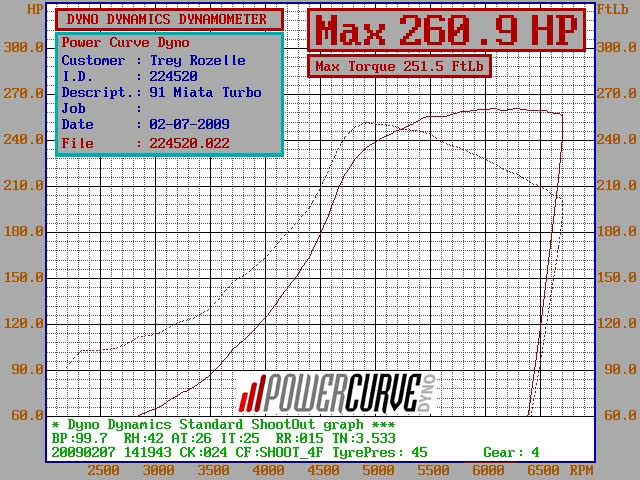Small (0.64 a/r) GT2860 dynos or boost datalogs
#21
Perhaps the smallest trim 2871 compressor (48 trim) is what the Potato ought to be - best for those who want 15-18 psi or 300-320 hp:
http://www.turbobygarrett.com/turbob...R_743347_1.htm
48 trim:
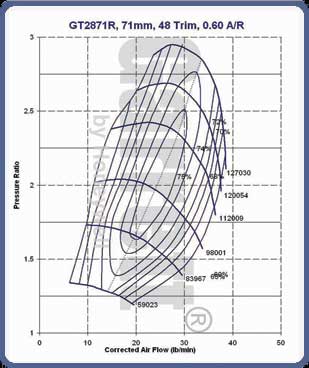
52 trim, like Savington's:
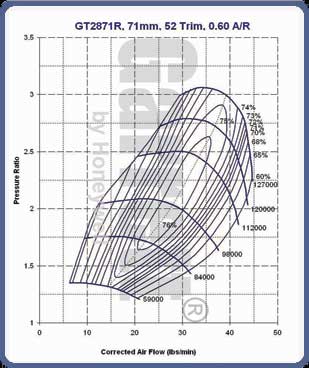
Here's the potato:
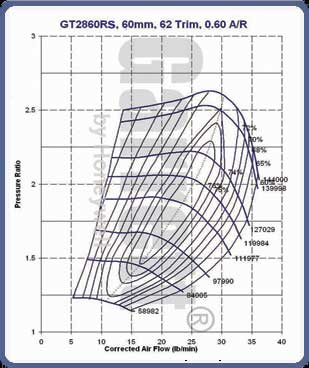
http://www.turbobygarrett.com/turbob...R_743347_1.htm
48 trim:

52 trim, like Savington's:

Here's the potato:

#22
Former Vendor

iTrader: (31)
Join Date: Nov 2006
Location: Sunnyvale, CA
Posts: 15,442
Total Cats: 2,099
Jason, the turbine maps don't show flow capability. I shouldn't have used the term "peak flow". They show the point at which the turbine begins to choke and build a pressure differential to actually perform work.
The corrected mass flow flatlines on the 2871R .86 at 21lb/min - but a 300whp Miata is moving ~33lb/min of air, and when you correct it (assuming EGTs of ~1600F and TIP of ~7psi) you end up at ~57lb/min - way more than the 21lb/min it can supposedly move.
If Garrett would release the real turbine maps, including the shaft RPMs at various corrected flow rates and pressure ratios, then we can start to get a better picture of how it all works.
Paging jkav.
The corrected mass flow flatlines on the 2871R .86 at 21lb/min - but a 300whp Miata is moving ~33lb/min of air, and when you correct it (assuming EGTs of ~1600F and TIP of ~7psi) you end up at ~57lb/min - way more than the 21lb/min it can supposedly move.
If Garrett would release the real turbine maps, including the shaft RPMs at various corrected flow rates and pressure ratios, then we can start to get a better picture of how it all works.
Paging jkav.
#23
Most of the (mass) flow is wastegated. The question is, what is the TIP (turbine inlet pressure) at the compressor's required shaft power and RPM, at the engine's mass flow rate and boost pressure...
The turbine plots however, do suggest that the GT28, even the 0.64, is sized for more flow than the GT25...
The turbine plots however, do suggest that the GT28, even the 0.64, is sized for more flow than the GT25...
#24
VitaminD, *if* your goal is 250 hp, you will be happy with the '2560 on the street and tight mountain roads. Don't understimate the value of response. My buddy with a 3071 chased me through some tight twisties with me and my 2560. On tight corner exits he said my car would leap ahead and he wouldn't be able to catch up because the straights were short. We both have 6 speeds and 3.9 rears, and were both using 3rd gear. 2nd gear would have been too short for him and the upshift would cost him time.
The 2560 is the perfect match for the stock motor because the latter can't take advantage of the higher boost the bigger turbos shine at. For an all-street car I would argue the 2554 is even better, giving up about 15-20 hp up top (maybe even less than that on an NA head) but generates oodles more torque and response at the bottom which is nice on a street car.
The 2560 is the perfect match for the stock motor because the latter can't take advantage of the higher boost the bigger turbos shine at. For an all-street car I would argue the 2554 is even better, giving up about 15-20 hp up top (maybe even less than that on an NA head) but generates oodles more torque and response at the bottom which is nice on a street car.
The dyno sheets that I have found the 2560 seems to fall off in the upper RPMs, I will be spending a lot of time there.
I'm curious to see what a 2860 .64 a/r turbo dyno looks like, I hope someone post one.
#26
Former Vendor

iTrader: (31)
Join Date: Nov 2006
Location: Sunnyvale, CA
Posts: 15,442
Total Cats: 2,099
Most of the (mass) flow is wastegated. The question is, what is the TIP (turbine inlet pressure) at the compressor's required shaft power and RPM, at the engine's mass flow rate and boost pressure...
The turbine plots however, do suggest that the GT28, even the 0.64, is sized for more flow than the GT25...
The turbine plots however, do suggest that the GT28, even the 0.64, is sized for more flow than the GT25...
#27
I've always wondered why getting our hands on the turbine maps is so damn hard, while compressor maps are a dime a dozen. Discussions like this remind me how frustrating it is to only be able to know half the story of what's going on, and half the information to really properly match up a turbo to one's goals.
#28
99% of people wouldn't know what to do with a turbine map. Still, it is unfortunate they're not out there. I think Borg's done the best job yet with their 'match-bot' thing, but even that lacks some turbine information to do a full, proper match.
Even with all the information on the map there are enough assumptions that go into a match that you always need to validate with a physical test on-vehicle. VE profile & true turbine inlet temp are big ones. Pressure losses through the comp inlet & CAC. Muffler system losses. On-engine pulse behavior at low expansion ratio has a HUGE effect on effective turbine efficiency that cannot be captured on a steady state turbine map (which all of them are).
Another thing is that the flow and speed on a turbine map is corrected to a higher inlet temp, so 1 lb/min of map turbine flow does not directly equate to 1 lb/min of map compressor flow.
Speaking of speed mismatch, here's something fun. A compressor wheel with a low degree of backward curvature to its blades turns slower for a given PR than a wheel with a high degree of backward curvature. So it behaves like a larger diameter wheel when it comes to matching to a turbine.
Even with all the information on the map there are enough assumptions that go into a match that you always need to validate with a physical test on-vehicle. VE profile & true turbine inlet temp are big ones. Pressure losses through the comp inlet & CAC. Muffler system losses. On-engine pulse behavior at low expansion ratio has a HUGE effect on effective turbine efficiency that cannot be captured on a steady state turbine map (which all of them are).
Another thing is that the flow and speed on a turbine map is corrected to a higher inlet temp, so 1 lb/min of map turbine flow does not directly equate to 1 lb/min of map compressor flow.
Speaking of speed mismatch, here's something fun. A compressor wheel with a low degree of backward curvature to its blades turns slower for a given PR than a wheel with a high degree of backward curvature. So it behaves like a larger diameter wheel when it comes to matching to a turbine.
#29
I measured TIP on my GT2554 and GT2560, at 10 psi boost. In both cases, TIP > MAP. On the 2560 I saw from 15-20 psi gauge pressure in the exhaust manifold. On the 2554, I saw TIP spike to 30 psi above 6000 RPM (suggesting that I'm hitting the efficiency wall (choke) of the compressor).
This is the primary reason why street turbo setups want minimal cam overlap. One way to reduce it, is to advance the exhaust cam. This also improves low-end spoolup. This is also probably why turbo setups like to have the VVT more retarded than n/a setups. (I compared my VVT map to an n/a setup some time ago).
#30
Hustler saw a huge gain in spoolup switching over from the BEGI log to the AF. (He claims full boost ~1000 RPM lower, which is a bit hard to believe). I see huge differences in other dyno plots, with the difference seemingly due to log vs. pulsey/tubey manifold.
FM's results for the 2860 vs the 2560 on their log mani were awful:
http://www.flyinmiata.com/tech/dyno_...emy_potato.pdf
#31
hmm, this small potato (0.64) made 175 ft-lbs (EDIT: at 3000 RPM) on a dynojet, and 344 hp peak, on a VW 1.8T:
http://forums.vwvortex.com/showthrea...Gt28RS.64-dyno
24 kg-m = 175 ft-lbs at just 3000 RPM:
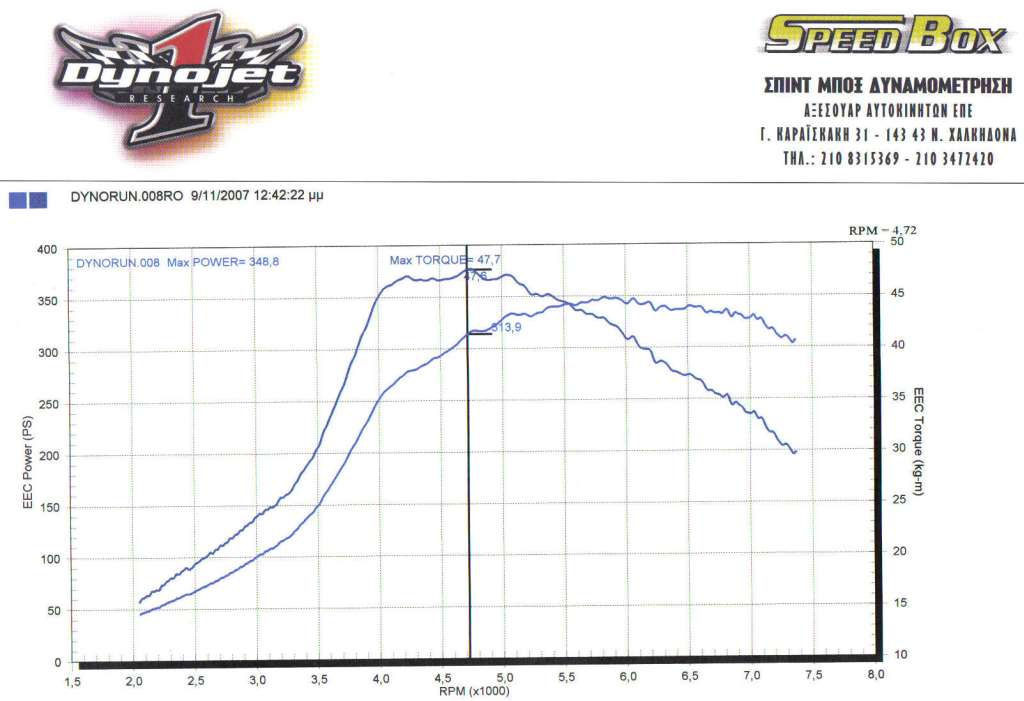
http://forums.vwvortex.com/showthrea...Gt28RS.64-dyno
24 kg-m = 175 ft-lbs at just 3000 RPM:

Last edited by JasonC SBB; 09-16-2011 at 08:10 PM.
#33
Moderator


iTrader: (12)
Join Date: Nov 2008
Location: Tampa, Florida
Posts: 20,652
Total Cats: 3,011
hmm, this small potato (0.64) made 175 ft-lbs on a dynojet, and 344 hp peak, on a VW 1.8T:
http://forums.vwvortex.com/showthrea...Gt28RS.64-dyno
24 kg-m = 175 ft-lbs
http://forums.vwvortex.com/showthrea...Gt28RS.64-dyno
24 kg-m = 175 ft-lbs
#34
Former Vendor

iTrader: (31)
Join Date: Nov 2006
Location: Sunnyvale, CA
Posts: 15,442
Total Cats: 2,099
It's 345tq, not 175tq. Making 344hp with only 175tq means ~10,300rpm. 
Doesn't mean the TIP isn't sky high, too. If they can combat it with high boost pressures (they are) and a good intake (they are) then you can drive more air through the thing. Our problem is restrictive intake manifolds, and once you fix that, we can't get the turbine pressure high enough to drive the shaft speed up to 24psi without inducing detonation.
Also, 24psi is a PR of ~2.6:1, and 345hp is ~38lb/min. Way, way off the end of the compressor map for a 2860RS, and probably way way past the max shaft RPM for the turbo too.

Doesn't mean the TIP isn't sky high, too. If they can combat it with high boost pressures (they are) and a good intake (they are) then you can drive more air through the thing. Our problem is restrictive intake manifolds, and once you fix that, we can't get the turbine pressure high enough to drive the shaft speed up to 24psi without inducing detonation.
Also, 24psi is a PR of ~2.6:1, and 345hp is ~38lb/min. Way, way off the end of the compressor map for a 2860RS, and probably way way past the max shaft RPM for the turbo too.
#35
Our problem is restrictive intake manifolds, and once you fix that, we can't get the turbine pressure high enough to drive the shaft speed up to 24psi without inducing detonation.





